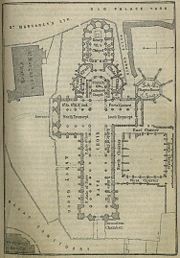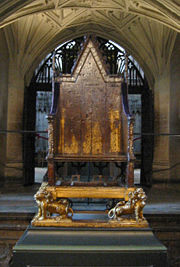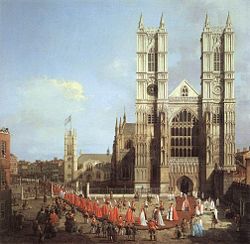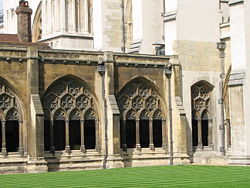Westminster Abbey
2008/9 Schools Wikipedia Selection. Related subjects: Architecture
| Westminster Palace, Westminster Abbey and Saint Margaret's Church* | |
|---|---|
| UNESCO World Heritage Site | |
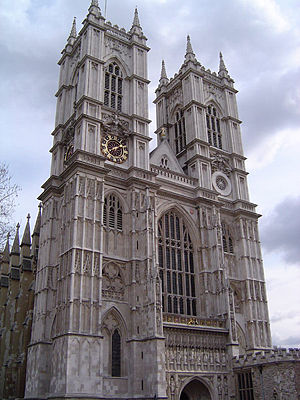 |
|
| State Party | |
| Type | Cultural |
| Criteria | I, II, IV |
| Reference | 426 |
| Region† | Europe and North America |
| Inscription history | |
| Inscription | 1987 (11th Session) |
| * Name as inscribed on World Heritage List. † Region as classified by UNESCO. |
|
The Collegiate Church of St Peter at Westminster, which is almost always referred to by its original name of Westminster Abbey, is a large, mainly Gothic church, in Westminster, London, just to the west of the Palace of Westminster. It is the traditional place of coronation and burial site for English monarchs. It briefly held the status of a cathedral from 1546–1556, and is currently a Royal Peculiar.
History
According to tradition a shrine was first founded in 616 on the present site, then known as Thorn Ey (Thorn Island); its tradition of miraculous consecration after a fisherman on the River Thames saw a vision of Saint Peter justifying the presents of salmon from the Thames fishermen that the Abbey received. In the 960s or early 970s Saint Dunstan, assisted by King Edgar, planted a community of Benedictine monks here. The stone Abbey was built around 1045–1050 by King Edward the Confessor and was later rebuilt again by Henry III in 1245, who had selected the site for his burial: it was consecrated on December 28, 1065, only a week before the Confessor's death and subsequent funeral. It was the site of the last coronation prior to the Norman Invasion, that of his successor King Harold.
The only extant depiction of the original Abbey, in the Romanesque style that is called Norman in England, together with the adjacent Palace of Westminster, is in the Bayeux Tapestry. Increased endowments supported a community increased from a dozen monks in Dunstan's original foundation, to about eighty monks.
The Abbot and learned monks, in close proximity to the Royal Palace of Westminster, the seat of government from the later twelfth century, became a powerful force in the centuries after the Norman Conquest: the Abbot was often employed on royal service and in due course took his place in the House of Lords as of right. Released from the burdens of spiritual leadership, which passed to the reformed Cluniac movement after the mid-tenth century, and occupied with the administration of great landed properties, some of which lay far from Westminster, "the Benedictines achieved a remarkable degree of identification with the secular life of their times, and particularly with upper-class life", Barbara Harvey concluded, to the extent that her depiction of daily life provides a wider view of the concerns of the English gentry in the High and Late Middle Ages. The proximity of the Palace of Westminster did not extend to providing monks or abbots with high royal connections; in social origin the Benedictines of Westminster were as modest as most of the order. The abbot remained Lord of the Manor of Westminster as a town of two to three thousand persons grew around it: as a consumer and employer on a grand scale the monastery helped fuel the town economy, and relations with the town remained unusually cordial, but no enfranchising charter was issued during the Middle Ages. The abbey built shops and dwellings on the west side, encroaching upon the sanctuary.
The Abbey became the coronation site of Norman kings, but none were buried there until Henry III, intensely devoted to the cult of the Confessor, rebuilt the Abbey in Anglo-French Gothic style as a shrine to honour Edward the Confessor and as a suitably regal setting for Henry's own tomb, under the highest Gothic nave in England. The Confessor's shrine subsequently played a great part in his canonisation. The work continued between 1245-1517 and was largely finished by the architect Henry Yevele in the reign of King Richard II. Henry VII added a Perpendicular style chapel dedicated to the Blessed Virgin Mary in 1503 (known as the Henry VII Chapel). Much of the stone came from Caen, in France ( Caen stone), the Isle of Portland ( Portland stone) and the Loire Valley region of France ( tuffeau limestone).

In 1535, the Abbey's annual income of £2400-2800 during the assessment attendant on the Dissolution of the Monasteries rendered it second in wealth only to Glastonbury Abbey. Henry VIII had assumed direct royal control in 1539 and granted the Abbey cathedral status by charter in 1540, simultaneously issuing letters patent establishing the Diocese of Westminster. By granting the Abbey cathedral status Henry VIII gained an excuse to spare it from the destruction or dissolution which he inflicted on most English abbeys during this period. Westminster was a cathedral only until 1550. The expression "robbing Peter to pay Paul" may arise from this period when money meant for the Abbey, which was dedicated to St Peter, was diverted to the treasury of St Paul's Cathedral.
The Abbey was restored to the Benedictines under the Catholic Queen Mary, but they were again ejected under Queen Elizabeth I in 1559. In 1579, Elizabeth re-established Westminster as a " Royal Peculiar" — a church responsible directly to the sovereign, rather than to a diocesan bishop — and made it the Collegiate Church of St Peter, (that is a church with an attached chapter of canons, headed by a dean). The last Abbot was made the first Dean. It suffered damage during the turbulent 1640s, when it was attacked by Puritan iconoclasts, but was again protected by its close ties to the state during the Commonwealth period. Oliver Cromwell was given an elaborate funeral there in 1658, only to be disinterred in January 1661 and posthumously hanged from a nearby gibbet.
The abbey's two western towers were built between 1722 and 1745 by Nicholas Hawksmoor, constructed from Portland stone to an early example of a Gothic Revival design. Further rebuilding and restoration occurred in the 19th century under Sir George Gilbert Scott. A narthex for the west front was designed by Sir Edwin Lutyens in the mid C20 but was not executed.
Until the 19th century, Westminster was the third seat of learning in England, after Oxford and Cambridge. It was here that the first third of the King James Bible Old Testament and the last half of the New Testament were translated. The New English Bible was also put together here in the 20th century.
Coronations
Since the coronations in 1066 of both King Harold and William the Conqueror, all English and British monarchs (except Edward V and Edward VIII, who did not have coronations) have been crowned in the Abbey. Henry III, was unable to be crowned in London when he first came to the throne because Prince Louis of France had taken control of the city and so was crowned in Gloucester Cathedral, but this coronation was deemed by the Pope to be improper, and a further coronation was held in the Abbey on 17 May 1220. Lady Jane Grey, whose reign lasted just nine days, and was of doubtful legality was also never crowned. The Archbishop of Canterbury is the traditional cleric in the coronation ceremony. King Edward's Chair (or St Edward's Chair), the throne on which British sovereigns are seated at the moment of coronation, is housed within the Abbey; from 1296 to 1996 the chair also housed the Stone of Scone upon which the kings of Scotland are crowned, but pending another coronation the Stone is now kept in Scotland.
Burials and memorials
Henry III rebuilt the Abbey in honour of the Royal Saint Edward the Confessor whose relics were placed in a shrine in the sanctuary and now lie in a burial vault beneath the 1268 Cosmati mosaic pavement, in front of the High Altar. Henry III was interred nearby in a superb chest tomb with effigial monument, as were many of the Plantagenet kings of England, their wives and other relatives. Subsequently, most Kings and Queens of England were buried here, although Henry VIII and Charles I are buried in St. George's Chapel at Windsor Castle, as are all monarchs and royals after George II.
Aristocrats were buried inside chapels and monks and people associated with the Abbey were buried in the Cloisters and other areas. One of these was Geoffrey Chaucer, who was buried here as he had apartments in the Abbey where he was employed as master of the Kings Works. Other poets were buried around Chaucer in what became known as Poets' Corner. Abbey musicians such as Henry Purcell were also buried in their place of work. Subsequently it became an honour to be buried or memorialised here. The practice spread from aristocrats and poets to generals, admirals, politicians, scientists, doctors, etc.. These include:
Buried
- See also: Category:Burials at Westminster Abbey
Monarchs and their consorts
The following English and British Monarchs and their consorts are buried in the Abbey:
- Edward the Confessor and wife Edith of Wessex
- Henry III of England
- Edward I of England and wife Eleanor of Castile
- Edward III of England and wife Philippa of Hainault
- Richard II of England and wife Anne of Bohemia
- Henry V of England and wife Catherine of Valois
- Edward V of England
- Henry VII of England and wife Elizabeth of York
- Edward VI of England
- Mary I of England
- Elizabeth I of England
- James I of England and wife Anne of Denmark
- Charles II of England
- Mary II of England
- William III of England
- Anne of Great Britain and husband Prince George of Denmark
- George II of Great Britain and wife Caroline of Ansbach
Other monarchs and consorts
- Anne Neville
- Anne of Cleves
- Mary Queen of Scots
- Elizabeth of Bohemia
Nave
The following are buried in the Nave
- Clement Attlee, 1st Earl Attlee
- Ernest Bevin
- Angela Georgina Burdett-Coutts
- Thomas Cochrane, 10th Earl of Dundonald
- Charles Darwin
- King St. Edward the Confessor
- George Graham
- Ben Jonson
- David Livingstone
- Charles Lyell
- James Clerk Maxwell
- Sir Isaac Newton
- Ernest Rutherford, 1st Baron Rutherford
- Robert Stephenson
- Ludovic Stewart, 2nd Duke of Lennox
- George Edmund Street
- J.J. Thomson
- William Thomson, 1st Baron Kelvin
- Thomas Tompion
- The Unknown Warrior
- George Villiers, 1st Duke of Buckingham
- Beatrice Webb
- Sidney James Webb, 1st Baron Passfield
- Freeman Freeman-Thomas, 1st Marquess of Willingdon
North Transept
- William Ewart Gladstone
- William Pitt, 1st Earl of Chatham
- William Pitt the Younger
- William Wilberforce
- Sir John Malcolm
South Transept
Poets' Corner
- Maj. John André
- Dame Peggy Ashcroft
- Robert Adam
- Robert Browning
- William Camden
- Thomas Campbell
- Geoffrey Chaucer
- William Congreve
- Abraham Cowley
- William Davenant
- John Denham
- Charles Dickens
- John Dryden
- Adam Fox
- David Garrick
- John Gay
- George Frederick Handel
- Thomas Hardy
- Sir Henry Irving
- Dr. Samuel Johnson
- Rudyard Kipling
- Thomas Macaulay
- John Masefield
- Lord Laurence Olivier
- Thomas Parr
- Richard Brinsley Sheridan
- Edmund Spenser
- Alfred Tennyson, 1st Baron Tennyson
Cloisters
- Aphra Behn
- Gen. John Burgoyne
- Muzio Clementi
- Percy Dearmer
- Lord Fraser of Lonsdale
- William Shield
North Choir Aisle
- Joseph R. Bray
- Henry Purcell
- Ralph Vaughan Williams
Chapel of St Paul
- Sir Rowland Hill
Henry VII Chapel
- Maj. Gen. Charles Worsley, though no memorial remains.
Commemorated
- Lord Byron
- Jane Austen, buried in Winchester Cathedral
- Robert, Lord Baden-Powell, buried in Nyeri, Kenya
- Charlotte Brontë, Emily Jane Brontë, Anne Brontë
- Sir Winston Churchill, buried at Bladon, Oxfordshire
- John Clare, buried in St. Botolph's churchyard, Helpston, Cambridgeshire
- Paul Dirac, buried in Florida
- Benjamin Disraeli, 1st Earl of Beaconsfield, buried at Hughenden Manor, Buckinghamshire
- Adam Lindsay Gordon, buried in Australia
- John Harrison, buried in St. John's Church in Hampstead
- Henry Wadsworth Longfellow, buried at Cambridge, Massachusetts
- Evelyn Levett Sutton, prebendary of Westminster who collapsed and died after reading the ninth commandment during Sunday services (in a monument)
- William Shakespeare, buried at Stratford-upon-Avon
- Oscar Wilde (in a stained glass window unveiled in 1995), buried in Paris
- Gen. James Wolfe, buried in Greenwich
- William Booth Founder of the Salvation army
- Above the Great West Door, ten 20th century Christian martyrs from across the world are depicted in statues; from left to right:
- St. Maximilian Kolbe
- Manche Masemola
- Janani Luwum
- Grand Duchess St. Elizabeth of Russia
- Martin Luther King, Jr.
- Óscar Romero
- Dietrich Bonhoeffer
- Esther John
- Lucian Tapiedi
- Wang Zhiming
Removed
The following were buried in the Abbey but later removed on the orders of Charles II:
- Oliver Cromwell, Lord Protector
- Adm. Robert Blake
- John Pym
The most recent person to be buried in the Abbey was Sir Laurence Olivier in 1989.
Schools
Westminster School and Westminster Abbey Choir School are also in the precincts of the Abbey. It was natural for the learned and literate monks to be entrusted with education, and Benedictine monks were required by the Pope to maintain a charity school in 1179; Westminster School may have been founded even earlier for children or novices, and the legendary Croyland Chronicle relates a story of 11th century king Edward the Confessor's Queen Editha chatting to a schoolboy in the cloisters, and sending him off to the Palace larder for a treat.
Organ
The organ was built by Harrison & Harrison in 1937, then with four manuals and 84 speaking stops, and was used for the first time at the Coronation of King George VI. Some pipework from the previous Hill organ of 1848 was revoiced and incorporated in the new scheme. The two organ cases, designed in the late nineteenth century by John Loughborough Pearson, were re-instated and coloured in 1959. In 1982 and 1987, Harrison and Harrison enlarged the organ under the direction of the then Abbey Organist Simon Preston to include an additional Lower Choir Organ and a Bombarde Organ: the current instrument now has five manuals and 109 speaking stops. In 2006 the console of the organ was refurbished by Harrison and Harrison, and space was prepared for two additional 16ft stops on the Lower Choir Organ and the Bombarde Organ.
Link to details of the organ on the National Pipe Organ Register.
Organists
|
|
|
Transport
- Nearest London Underground stations:
- St. James's Park (District, Circle lines)
- Westminster (Jubilee, District, Circle lines)
Chapter
The Abbey is a collegiate church organised into the College of St Peter, which comprises the Dean and four residentiary Canons (one of whom is also Rector of St Margaret's Church, Westminster, and Speaker's Chaplain), and seventeen other persons who are members ex officio, as well as twelve lay vicars and ten choristers. The seventeen are the Receiver-General and Chapter Clerk, the Registrar, the Auditor, the Legal Secretary and the Clerk of the Works (the administrative officers). Those more directly concerned with liturgical and ceremonial operations include the Precentor, the Chaplain and Sacrist, the Organist, and the (honorary) High Steward and High Bailiff. The Abbey and its property is in the care of the Librarian, the Keeper of the Muniments, and the Surveyor of the Fabric. Lastly, the educational role of the Abbey is reflected in the presence of the Headmaster of the Choir School, the Headmaster and Under Master of Westminster School, and the Master of The Queen's Scholars.
The Abbey is governed by the Dean and Chapter established under the Elizabethan statute of 1560. This consists of the Dean and the four residentiary Canons.
Museum
The Westminster abbey museum is located in the 11th century vaulted undercroft of St Peter beneath the former monks' dormitory in Westminster Abbey. This is one of the oldest areas of the Abbey, dating back almost to the foundation of the Norman church by King Edward the Confessor in 1065.
Exhibits
The exhibits include a unique collection of royal and other funeral effigies (funeral saddle, helm and shield of Henry V), together with other treasures, including some panels of medieval glass, 12th century sculpture fragments, Mary II's coronation chair and replicas of the Coronation regalia, effigies of Edward III, Henry VII and his queen, Elizabeth I, Charles II, William III, Mary II and Queen Anne.
Later wax effigies include a striking likeness of Horatio, Viscount Nelson wearing some of his own clothes and another of the famous Prime Minister William Pitt, Earl of Chatham, modelled by an American lady called Patience Wright. During recent conservation of Elizabeth I's effigy a unique corset dating from 1603 was found on the figure and is now displayed separately.
A recent addition to the display is the late 13th century Westminster Retable, England's oldest altarpiece. It was most probably designed for the High Altar of the Abbey, although it has been damaged in past centuries. The panel has been expertly cleaned and conserved. One section shows the figure of St Peter, the patron saint of the Abbey.
